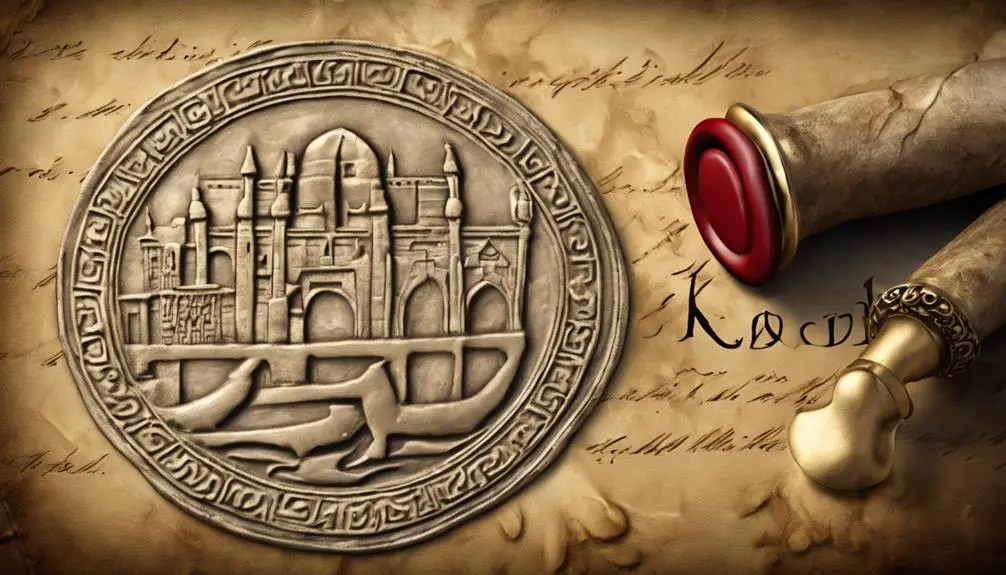Yielding profound symbolism, the signet ring in the Bible marks authority, identity, and divine promises, inviting a deeper exploration of its sacred significance.

Significance of Signet Ring in the Bible
In the tapestry of biblical narratives, the signet ring emerges not just as an ornament but as a symbol woven with threads of authority, identity, and covenant. You'll find that its significance is far from superficial; it carries the weight of divine promises and human destinies.
From its historical origins to its reflections in the New Testament, the signet ring's role is pivotal. As you explore its layered meanings, you'll uncover how it marks not only personal identity but also divine sanction and promises that echo through the ages.
The journey through its symbolism offers a deeper understanding of biblical themes, beckoning you to look closer.
Key Takeaways
- Signet rings symbolize divine authority and the continuity of God's will through covenants in biblical narratives.
- They reflect personal identity, belonging, and the spiritual lineage within the context of divine promises.
- In the New Testament, signet imagery illustrates spiritual authority and the apostolic mission to spread the Gospel.
- Signet rings served practical roles in governance, authenticating documents and ensuring the legitimacy of royal decrees and agreements.
Historical Context and Origins

Signet rings, deeply embedded in ancient Near Eastern culture, played a pivotal role in both societal and religious contexts, serving as symbols of authority and identity. These artifacts, borne out of ancient craftsmanship, weren't merely ornamental but functional, embodying the wearer's status and privileges. The intricate designs and symbols engraved on them were unique to their owners, making these rings an essential tool for authentication and security.
Royal uses of signet rings were particularly notable. Kings and high-ranking officials used them to seal documents, imbuing the imprint with legal and ceremonial significance. This practice underscored the rings' role in governance and administration, acting as a portable signature that could authenticate decrees, letters, and transactions. The craftsmanship involved in creating these rings was highly specialized, requiring skilled artisans to carve intricate designs into durable materials like stone, metal, or ivory. This level of detail ensured that each ring was both a work of art and a symbol of power.
Thus, signet rings in the ancient Near East weren't mere accessories but critical tools in the machinery of state and society, reflecting the complex interplay between art, authority, and identity.
Symbol of Divine Authority

Within the biblical narrative, signet rings transcend their conventional role, embodying divine authority and serving as tangible symbols of God's covenant with His people. These rings aren't merely ornamental; they're imbued with the power to enact royal decrees and signify the transfer of power, echoing the divine will in the temporal realm.
In this context, you'll find that the signet ring acts as a conduit through which divine authority is manifested. Its use in the issuance of royal decrees isn't just a matter of protocol; it's a reflection of a higher endorsement, a divine sanction that legitimizes the command. This aspect is critical, as it underlines the belief that monarchs were divinely appointed, their authority an extension of God's sovereignty over His creation.
Moreover, the act of transferring power through a signet ring symbolizes more than a political maneuver; it represents the continuation of divine will through human agency. This symbolic act underscores the profound relationship between the divine and the temporal authorities, establishing a continuum of divine authority that transcends mere human governance.
Covenant and Promise

Reflecting on the symbolic transfer of divine authority through signet rings, it's crucial to explore how these artifacts also signify God's covenants and promises to His people. In biblical narratives, signet rings often symbolize more than mere authority; they're emblematic of the deep, covenantal relationships God establishes with His creations. These covenants are sealed, much like royal seals imprint authority and authenticity on decrees, marking an unbreakable promise between God and humanity.
Symbol |
Covenant |
Significance |
|---|---|---|
Signet Ring |
Noahic |
God's promise of never again destroying the earth with a flood. |
Royal Seals |
Abrahamic |
God's promise to Abraham of numerous descendants and land. |
Marriage Metaphor |
Mosaic |
The law as a symbol of the marriage contract between God and Israel. |
New Covenant |
Davidic & New Testament |
Promise of a Messiah and a new heart for God's people. |
These covenants, represented through the metaphor of marriage and sealed by the divine signet, underscore a relationship that's both sovereign and intimate. The signet ring, in this context, serves as a tangible reminder of God's unwavering commitment to His promises, bridging the heavenly with the earthly in a bond marked by fidelity and love.
Identity and Belonging

As we delve into the concept of identity and belonging, it's essential to recognize how biblical narratives use symbols like signet rings to articulate the profound connection between an individual's identity and their sense of belonging within a divine covenant. Signet rings, often passed down as family heirlooms, serve not only as personal identifiers but also as emblematic of one's lineage and standing within their community. This connection is deeply rooted in the cultural significance these items hold, reflecting an intricate tapestry of familial and divine relationships.
Here are key points to consider:
- Signet Rings as Symbols of Authority: In biblical times, signet rings were emblematic of authority and power, signifying the wearer's rank and role within their society and family.
- Family Heirlooms: These rings often became family heirlooms, representing continuity and the enduring nature of familial bonds across generations.
- Cultural Significance: Beyond their material value, signet rings held profound cultural significance, embodying the collective identity and heritage of a family or tribe.
- Markers of Divine Covenant: They also symbolized an individual's inclusion in a divine covenant, marking them as belonging to a greater, spiritual lineage.
Reflections in New Testament

Signet rings, transitioning from their Old Testament significance, emerge in the New Testament as nuanced symbols of authority and identity, underscoring the evolving nature of divine relationships. This evolution reflects the broader thematic shift towards spiritual rather than earthly authority and the personal, direct relationship between individuals and the divine. In this context, Jesus' parables often employ imagery and metaphors familiar to his audience, including references to seals and signets, to illustrate the kingdom of heaven and the nature of divine authority and protection.
The Apostolic roles further embody the signet ring's symbolism, representing the authority bestowed upon the apostles to act in Jesus' name, spread the Gospel, and establish the church. Their roles, akin to signet rings, signify the trust and authority Jesus placed in them, marking them as his representatives on earth, tasked with authenticating and disseminating his teachings. This transformation of the signet ring's symbolism from a marker of earthly power and identity to one of spiritual authority and mission encapsulates the New Testament's redefinition of divine relationships, focusing on faith, individual responsibility, and the spread of the Gospel.
Frequently Asked Questions
How Did the Design and Material of Signet Rings Vary Across Different Cultures Mentioned in the Bible?
In different cultures mentioned, signet rings varied significantly in design and material. You'll find that craftsmen employed various engraving techniques tailored to the ring's purpose, from sealing documents to representing authority.
The ring inscriptions themselves held distinct meanings, influenced by the wearer's culture and status. Metals ranged from gold for the elite to simpler materials for the common folk, reflecting the societal hierarchy and the ring's significance within it.
Were There Any Specific Rituals or Ceremonies Associated With the Giving or Receiving of Signet Rings in Biblical Times?
In biblical times, the giving or receiving of signet rings wasn't just a mere exchange of gifts. Rather, it involved rituals or ceremonies symbolizing seal authentication and power transfer.
These ceremonies underscored the ring's significance, marking authority or trust bestowed upon the receiver. You'd find that such practices highlighted the trust and responsibility transferred with the ring, making the ceremony a crucial aspect of its exchange.
Can We Find Evidence of Women Owning or Wearing Signet Rings in Biblical Narratives, and What Would Their Roles or Significance Be?
You'll find that in biblical narratives, evidence of women owning or wearing signet rings is scarce. This scarcity reflects the gender roles of the time, where men predominantly held positions of power and authority.
However, when women did possess these rings, it wasn't just about fashion trends; it signified their exceptional status or involvement in significant activities, suggesting a level of autonomy and influence not commonly attributed to women in those historical contexts.
How Has the Symbolism and Use of Signet Rings Evolved in Christian Traditions Post-Bible Times?
You're diving into how signet rings, once symbols of authority and identity, have morphed in Christian traditions beyond biblical times. Modern symbolism intertwines with ecclesiastical usage, reflecting a deepened spiritual significance.
These rings now often symbolize faith, commitment, and the bearer's connection to the church. Analyzing their evolution, you'll find that signet rings serve not just as personal emblems but as markers of communal identity and sacred responsibility within Christian contexts.
Are There Any Significant Differences in the Portrayal of Signet Rings Between the Various Translations and Interpretations of the Bible?
You'll find that translation accuracy and interpretation variance play crucial roles in how signet rings are depicted across different Bible translations.
While some versions might emphasize their symbolic authority and identity, others could offer a nuanced understanding, reflecting cultural and historical contexts.
It's important to critically compare these translations to grasp the full spectrum of meanings.
Such disparities underscore the importance of scholarly analysis in understanding biblical symbols.
Conclusion
In conclusion, the signet ring in the Bible serves as a multifaceted symbol, embodying divine authority, covenantal promises, and personal identity. Like a lighthouse guiding ships home, it illuminates the path to understanding the intricate relationship between God and His people.
Through its historical context and reflections in the New Testament, the signet ring's significance transcends mere ornamentation, offering a profound glimpse into the nature of divine interaction and human response within the biblical narrative.



Sign up